‘The Himalayas’ is often associated with the Indian Mountain ranges. But there is more to it than just that. The beautiful state of Uttarakhand in India is divided into Garhwal and Kumaon regions. While Garhwal has 7 districts including Chamoli, Dehradun, Kumaon has 6 districts – Almora, Bageshwar, Champawat, Nainital, Pithoragarh and Udham Singh Nagar. Kumaon region is the eastern part of the state and is bordered by Tibet and Nepal.
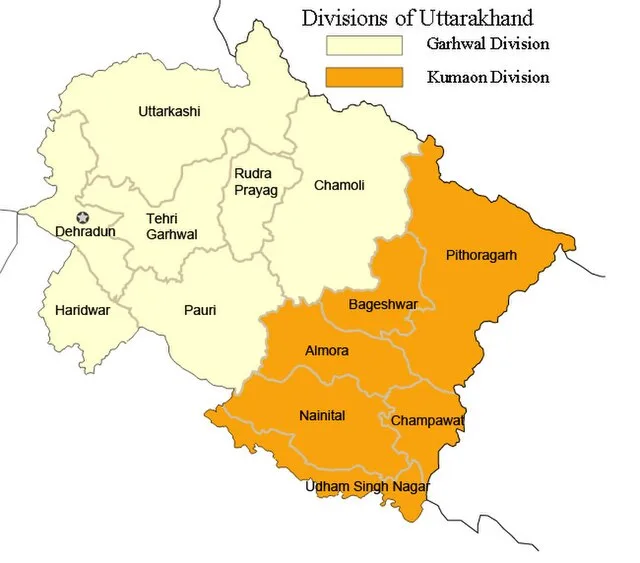
Home to places like Nainital known for its lakes, Bageshwar for its Bagnath Temple, and Almora, Kumaon Himalayas is a beautiful blend of landscapes, culture, and history.
Table of Contents
Historical Legacy
Historically, it was the heart of the Kumaon Kingdom, ruled by the Katyuri and Chand dynasties, whose legacies are evident in its temples, festivals, and art forms.
The Katyuris originating from Kartikeyapura, unified Kumaon in the 7th century under Vasu Dev. Under their rule Shaivism flourished and temples like Jageshwar and Katarmal were constructed. The administration prioritized infrastructure, building roads and bridges that facilitated trade across the Himalayas. By the 11th century, political fragmentation led to the dynasty’s decline, splitting Kumaon into eight kingdoms.
In the 13th century, the Chands reunified Kumaon and expanded their territory from the Tons River to Nepal’s Karnali River. They shifted the capital from Champawat to Almora in 1563. Their patronage of folk Hinduism and Kumaoni language revitalized regional identity. The Nanda Devi Raj Jat, a 12-yearly pilgrimage honoring the patron goddess of the Chands, originated during this era. By the 18th century, financial crises and internal strife weakened the kingdom, paving the way for British annexation in 1815.
Culture of Kumaon: People, Art, and Traditions
The Kumaoni People
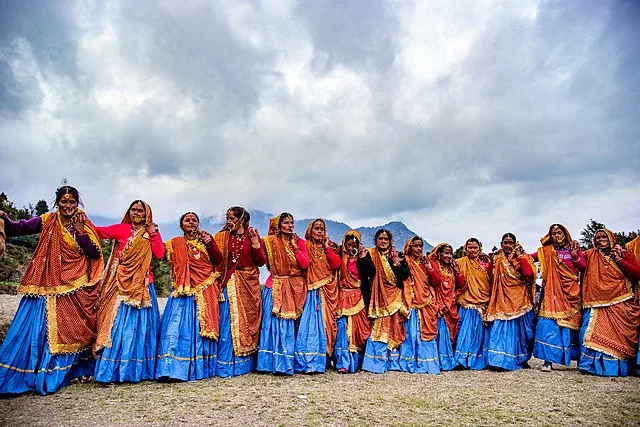
Kumaonis speak the Kumaoni language. Their society comprises diverse communities, including Tharus, Bhutiyas, and Rajis, each preserving distinct customs. Traditional attire like the Pichhaura (a embroidered dupatta) is worn during festivals, while cuisine features Bhatt ki Churkani (black soybean curry) and Bal Mithai (a fudge-like sweet). Aloo Ke Gutke, Baadi, Singodi, Lesu, Jhangora ki kheer are other notable dishes of the region.
Aipan: The Sacred Art of Kumaon
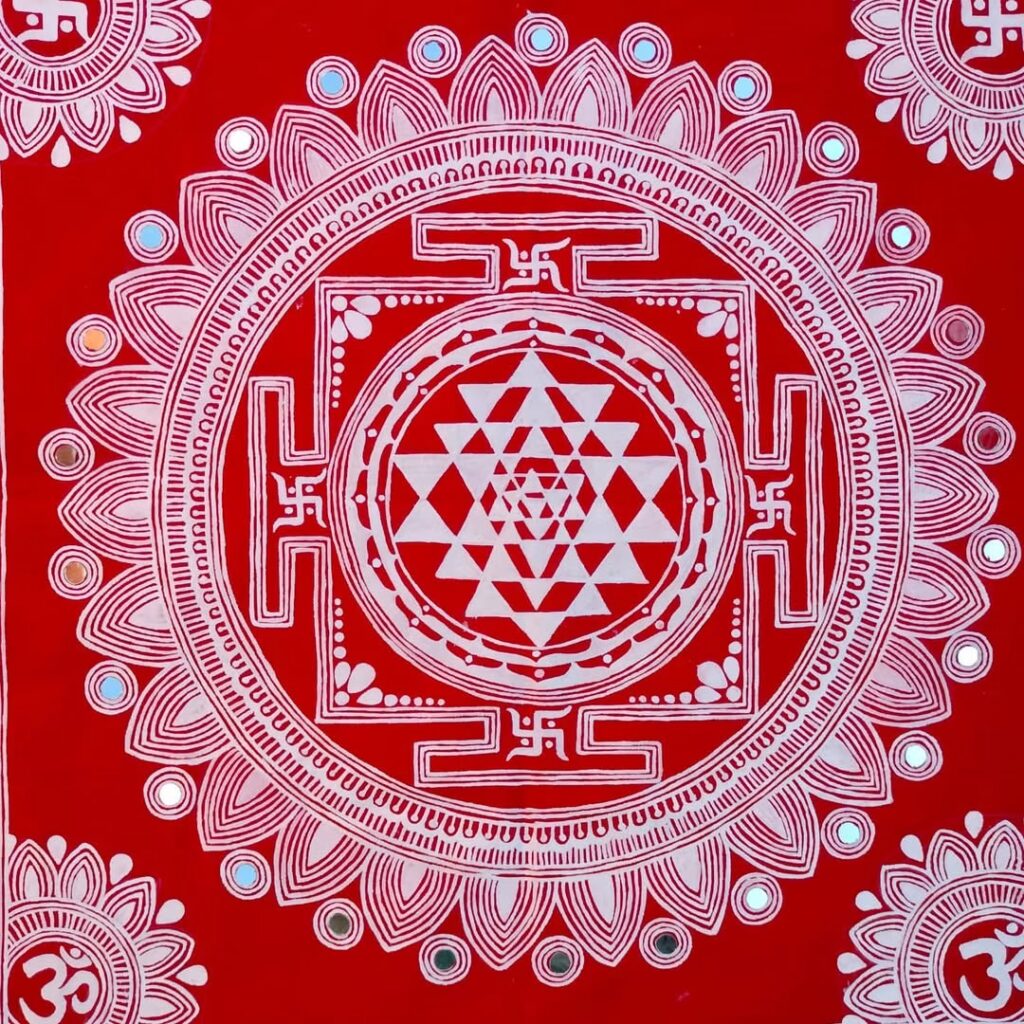
Aipan, a ritualistic floor and wall art, adorns homes during festivals like Harela and weddings. Using rice paste and ochre, women create geometric patterns and deities’ motifs, believed to invoke blessings. Contemporary artists have revived Aipan on products like diaries, coasters, and sarees, blending tradition with modernity.
Festivals and Folklore:
Kumaoni Holi: A week-long musical celebration filled with singing and dancing, distinguished by its classical raga-based songs. It features three main forms—Baithki, Khari, and Mahila Holi—each performed with specific traditions.
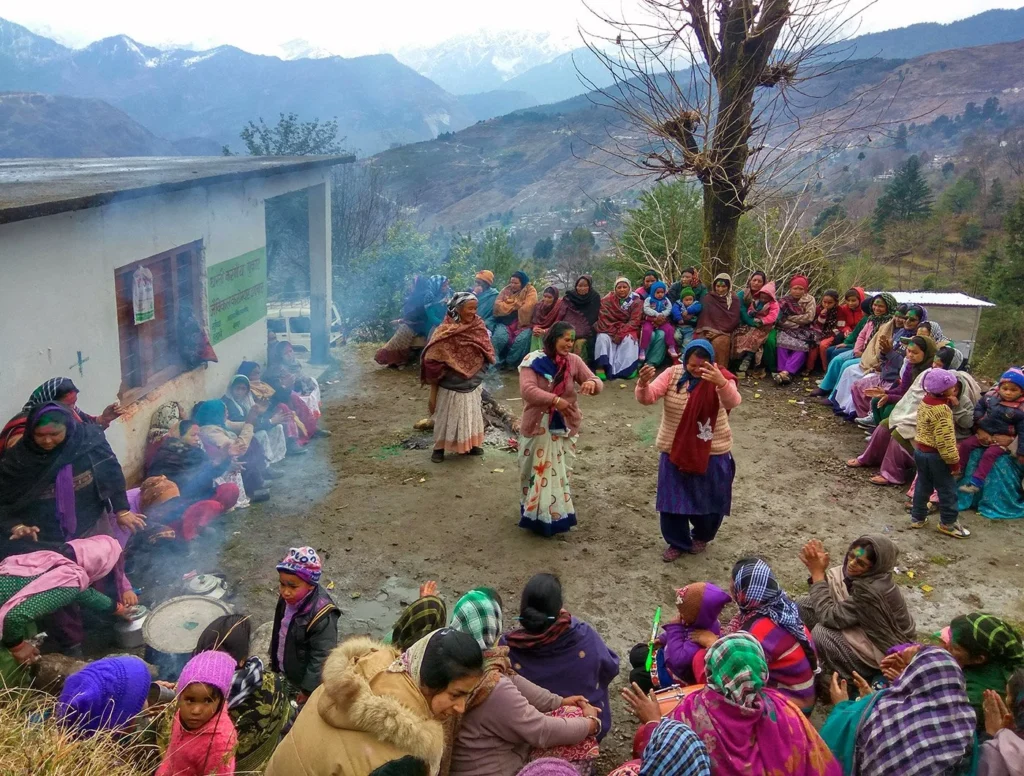
Harela & Bhitauli: Marks the start of the sowing season and the symbolic wedding of Lord Shiva and Parvati. People grow and exchange green shoots (Harela) for good fortune. Clay idols are worshipped, animals are rested, and Bhitauli gifts are exchanged—especially from brothers to sisters—signifying blessings and prosperity.
Janopunyu: Coinciding with Raksha Bandhan, this festival marks the ritual renewal of the sacred thread (janeu) by Brahmins. It is celebrated alongside the famous Bagwal fair in Devidhura, known for its traditional stone-pelting ritual performed as a symbolic battle.
Ganga Dusshera: Held in May–June, this festival celebrates the descent of the Ganges from heaven to Earth. People bathe in holy rivers and decorate their homes and temples with Dasar posters, geometric paper designs believed to bring purification and blessings.
Ghughutia / Uttarayani: Celebrated during Makar Sankranti, children wear garlands made of sweetmeats to attract crows and migratory birds, welcoming them back to the hills. Offerings of khichdi and community fairs highlight this harvest-and-astronomical festival of seasonal transition.
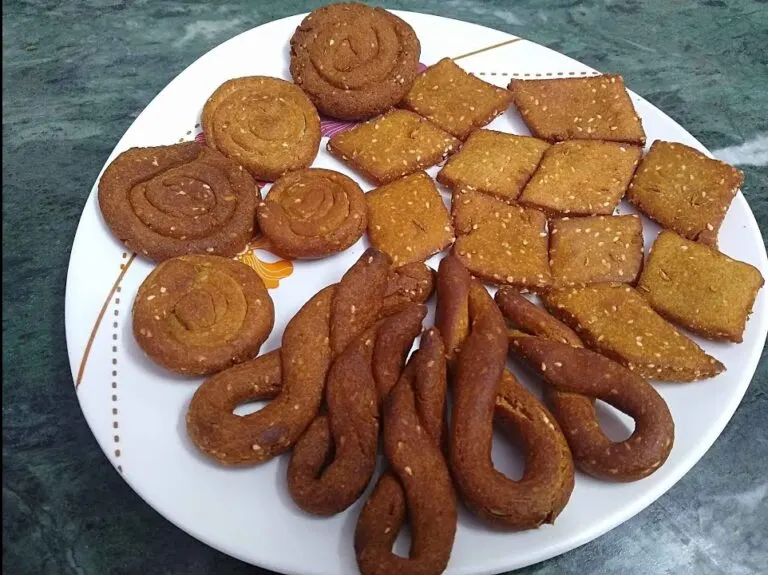
Khatarua: Khatarua, observed in mid-September, celebrates the onset of autumn and the wellbeing of livestock. Bonfires are lit, children dance around them with flags, and offerings like cucumbers are made to the fire to ward off evil and commemorate a historical victory.
Phool Dei: Celebrated on the first day of Chaitra (March), this springtime festival sees young girls going door-to-door, blessing homes with rice, flowers, and sweets. In return, they receive gifts, symbolizing goodwill, community harmony, and seasonal renewal.
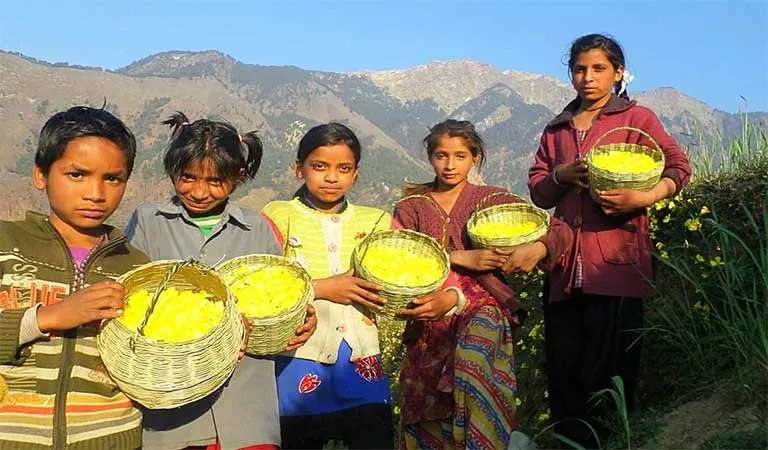
Hilljatra: Celebrated in Pithoragarh, Hilljatra is a vibrant agrarian festival that blends rituals, masks, and dramatic performances. It is rooted in pastoral traditions and celebrates rice planting, with origins linked to Nepal and legends of royal victory. The festivities include sacrifices, masked dances, and traditional music through the night.
Highest Peaks in Kumaon Himalayas
Nanda Devi Range
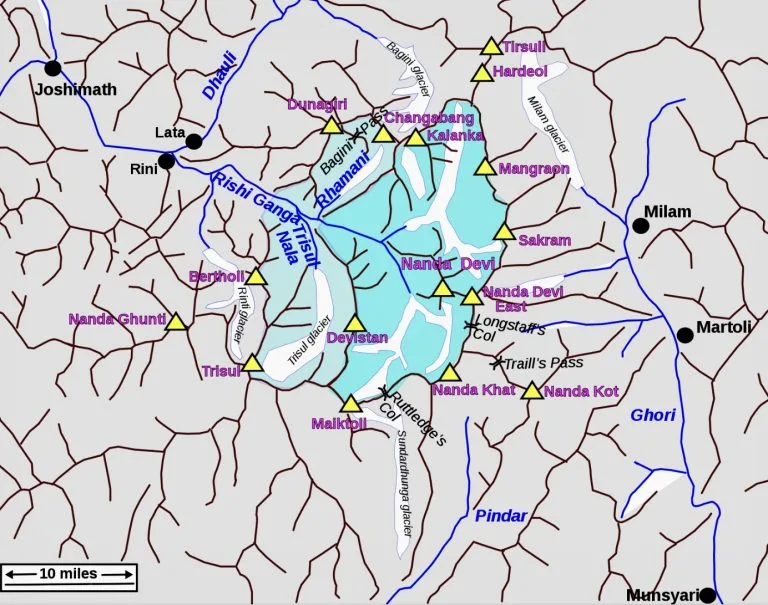
The Nanda Devi Range is the most prominent and spiritually revered mountain range in the Kumaon Himalayas. It has the towering Nanda Devi East (7,434 m), often called the “Goddess of Bliss,” which is considered the twin of the Nanda Devi peak located in Garhwal. This range forms the eastern boundary of the Nanda Devi Biosphere Reserve, a UNESCO World Heritage Site known for its alpine meadows, endemic species, and sacred significance. The Nanda Devi range dominates the skyline from places like Munsiyari, Martoli, and Milam, and is deeply embedded in Kumaoni folklore and tradition.
Panchachuli Range
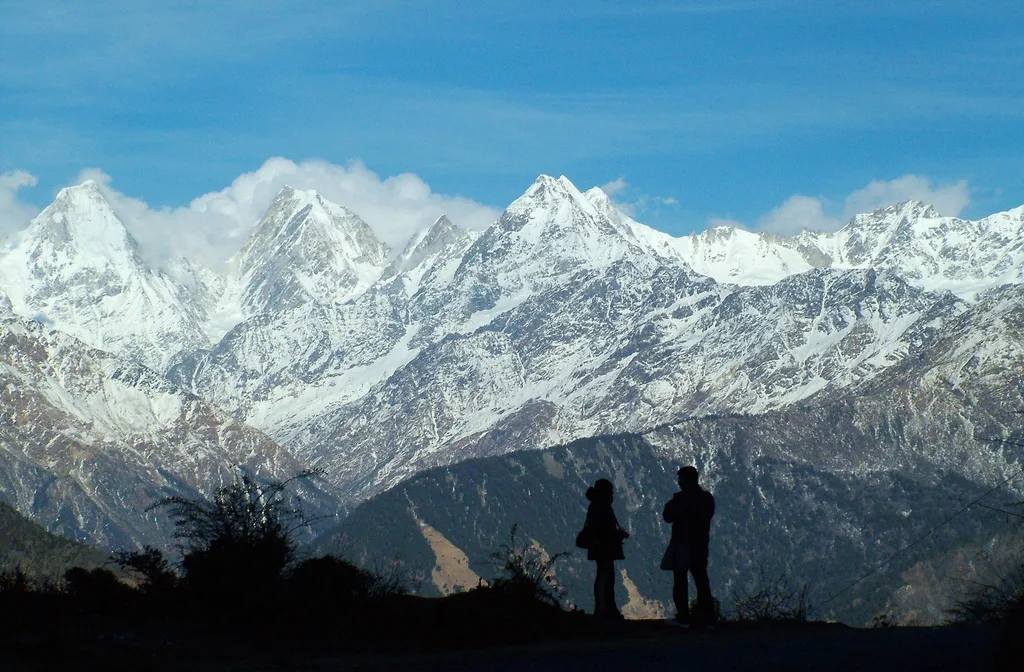
Located in the easternmost part of Kumaon, the Panchachuli Range consists of five snow-clad peaks, each rising above 6,300 meters. The name “Panchachuli” is derived from the legend that the five Pandavas from the Mahabharatha epic, cooked their last meal here before ascending to heaven, giving it both mythological and visual appeal. This range borders the Darma Valley, and the trek to its base camp offers up-close views of the glaciers, Meola and Saun, that feed into the Gori Ganga River. The range is iconic for its symmetrical beauty, and leaves one stunned!
Trishul–Maiktoli Range
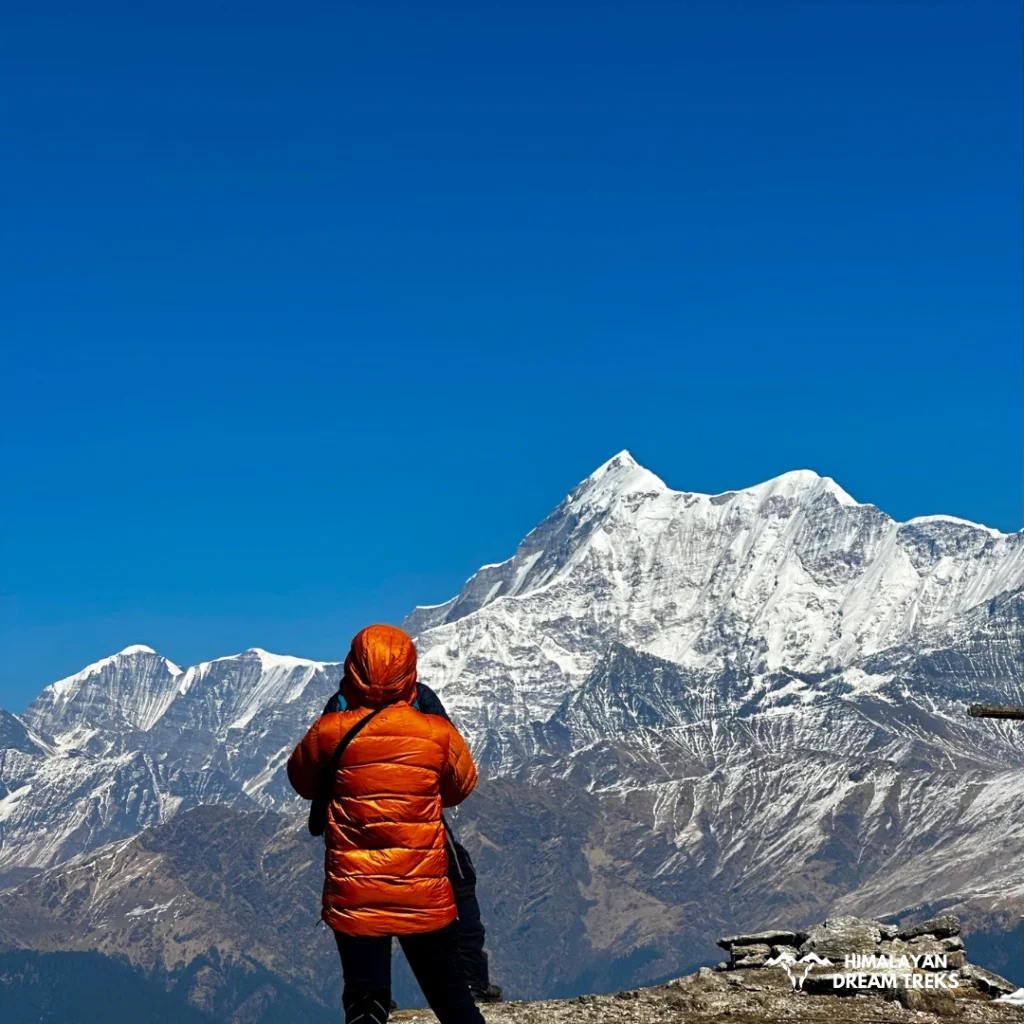
Stretching across parts of Almora and Bageshwar districts, the Trishul–Maiktoli Range forms a barrier between the Pindari and Sunderdhunga valleys. The Trishul massif, shaped like a trident, is one of the first 7,000+ meter peaks to be climbed by an Indian expedition. The range is known for its icy ridges, hidden valleys, and connections to several glacier systems, including Pindari, Sunderdhunga, and Kafni. It offers some of Kumaon’s most breathtaking trekking backdrops and is a hotspot for alpine biodiversity.
Nandakot Range
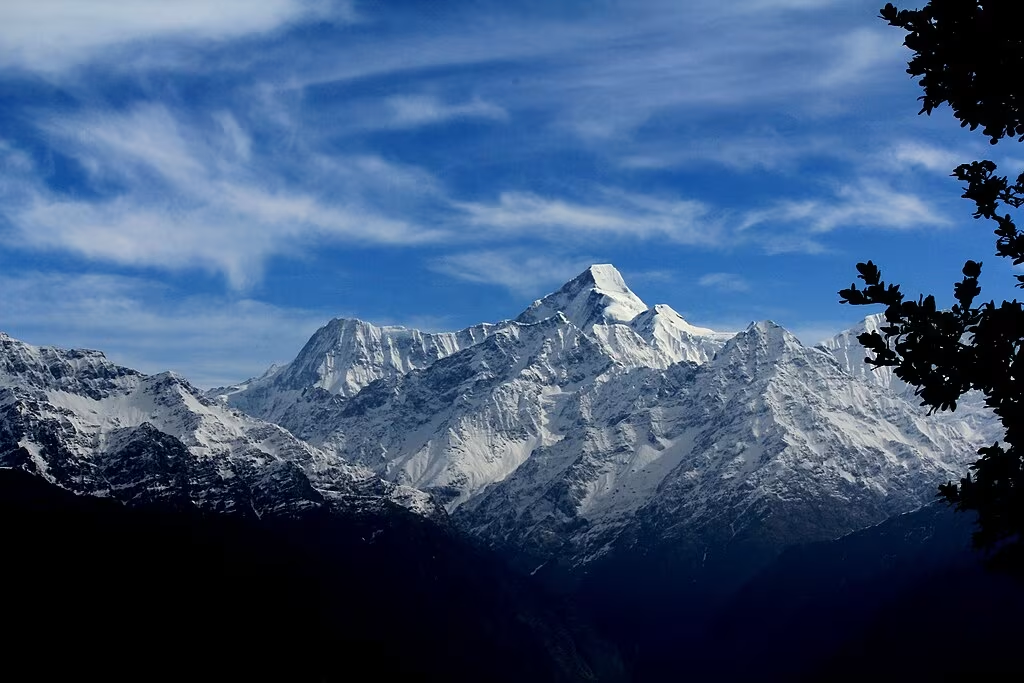
The Nandakot Range, located southeast of Nanda Devi East, is crowned by Nandakot Peak (6,861 m). This massif acts as a transitional bridge between the Nanda Devi Sanctuary and the eastern glaciers like Kafni and Sunderdhunga. It’s a lesser-known yet powerful segment of the Himalayas, flanked by high ridgelines and steep ice faces. Nandakot has both strategic and spiritual significance and is surrounded by remote villages such as Sola, Gogina, and Dwali, which serve as base points for trekkers. The range has witnessed few climbing expeditions due to its difficult access and weather conditions.

Below are the notable highest peaks which are a part of the Nanda Devi range that spans across the Garhwal Himalayas-Kumaon Himalayas, and Panchchuli range.
| Peak | Altitude | Region |
| Hardeol Peak | 23,461 feet | Chamoli–Pithoragarh |
| Tirsuli | 23,209 feet | Chamoli–Pithoragarh |
| Panchchuli II | 22,468 feet | Pithoragarh |
| Mrigthuni | 22,490 feet | Chamoli-Bageshwar |
| Maiktoli | 22,320 feet | Chamoli-Bageshwar |
| Mangraon | 21,549 feet | Chamoli–Pithoragarh |
Other mountain peaks include – Rajrambha, Chaudhara, Sangthang, Nagalaphu.
Kumaon’s Destinations
Trekking in Kumaon Himalayas:
Pindari Glacier Trek
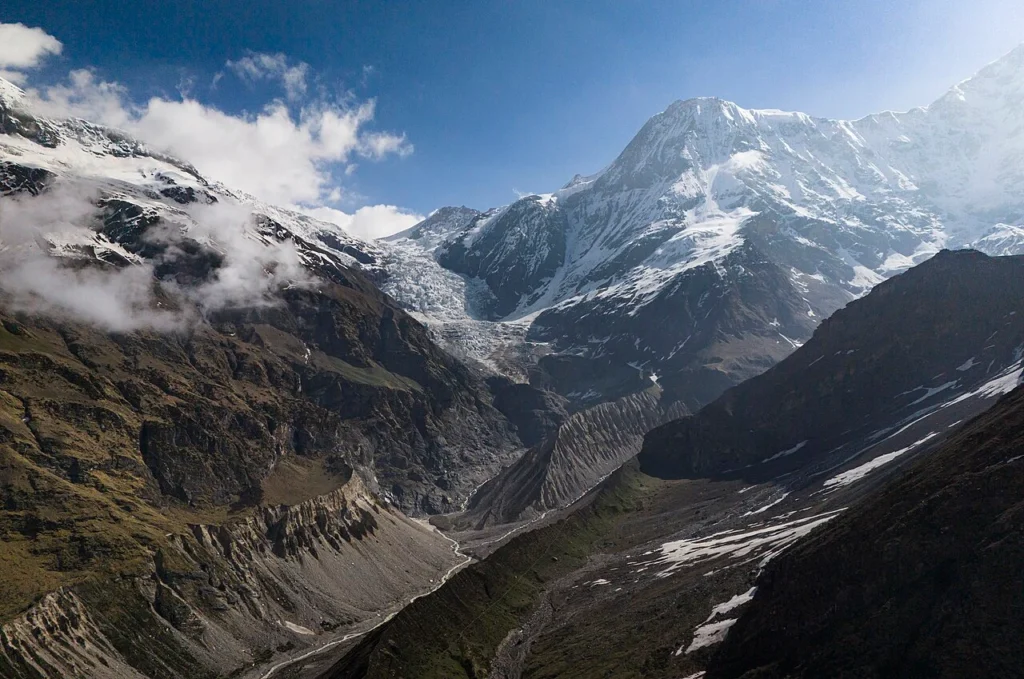
The Pindari Glacier Trek is one of the most popular and beginner-friendly high-altitude treks in the Kumaon region. Reaching a maximum altitude of approximately 12,008 feet at Zero Point, this trek offers a stunning mix of natural beauty and accessibility. The journey begins at Kathgodam and progresses through the scenic town of Bageshwar, moving up via Loharkhet, Dhakuri, Khati before reaching the glacier.
The trek usually takes 6–7 days and covers lush rhododendron forests, traditional villages, and roaring glacier-fed rivers. The route provides panoramic views of peaks like Nanda Kot and Maiktoli. The terrain is relatively gentle, making it ideal for first-time trekkers or families. No special permits are needed, although forest registration and a valid ID are mandatory. The best seasons for this trek are April to June and September to November.
Kafni Glacier Trek
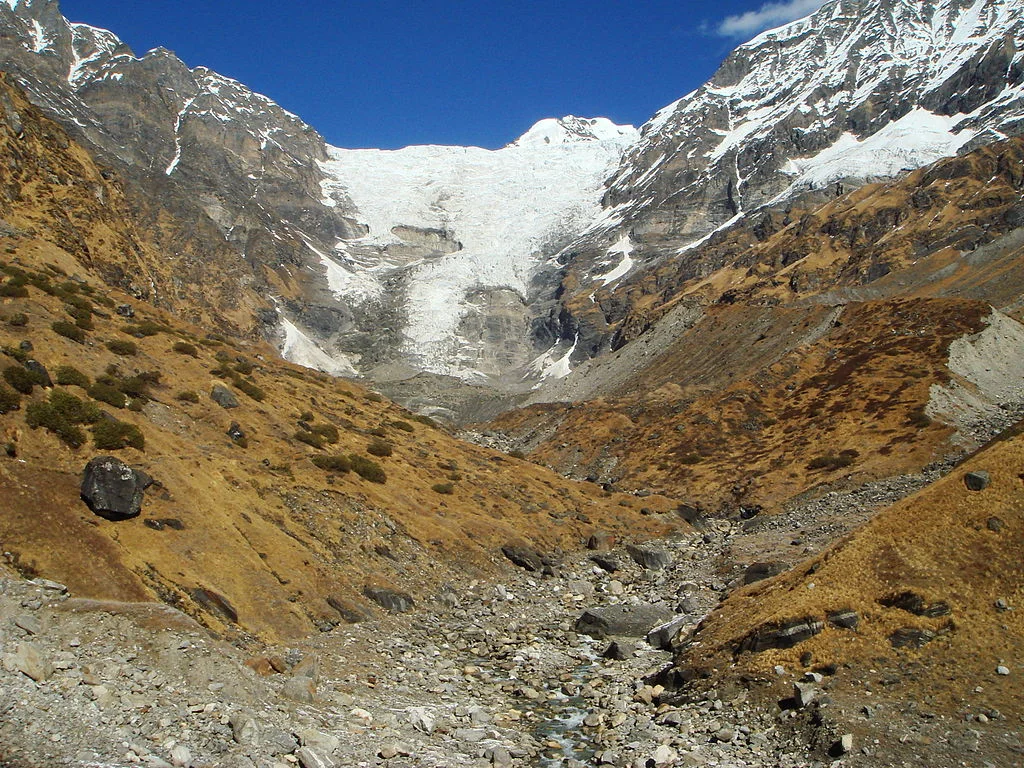
Often considered a peaceful sibling to the Pindari route, the Kafni Glacier Trek is an ideal choice for trekkers looking for solitude, alpine charm and glacier trek. Located at around 12,694 feet, it branches off from the Pindari trail at Dwali and heads toward the Kafni River’s origin. The trek spans 8 days and includes rolling meadows, floral patches, icy streams, and snow bridges.
With limited crowds and pristine views of Nandakot, this trek offers a spiritual and scenic journey through some of Kumaon’s purest landscapes. The difficulty is moderate, and no formal permits are required—only ID registration at forest check-posts. It’s best done between April to June and September to October.
Milam Glacier Trek
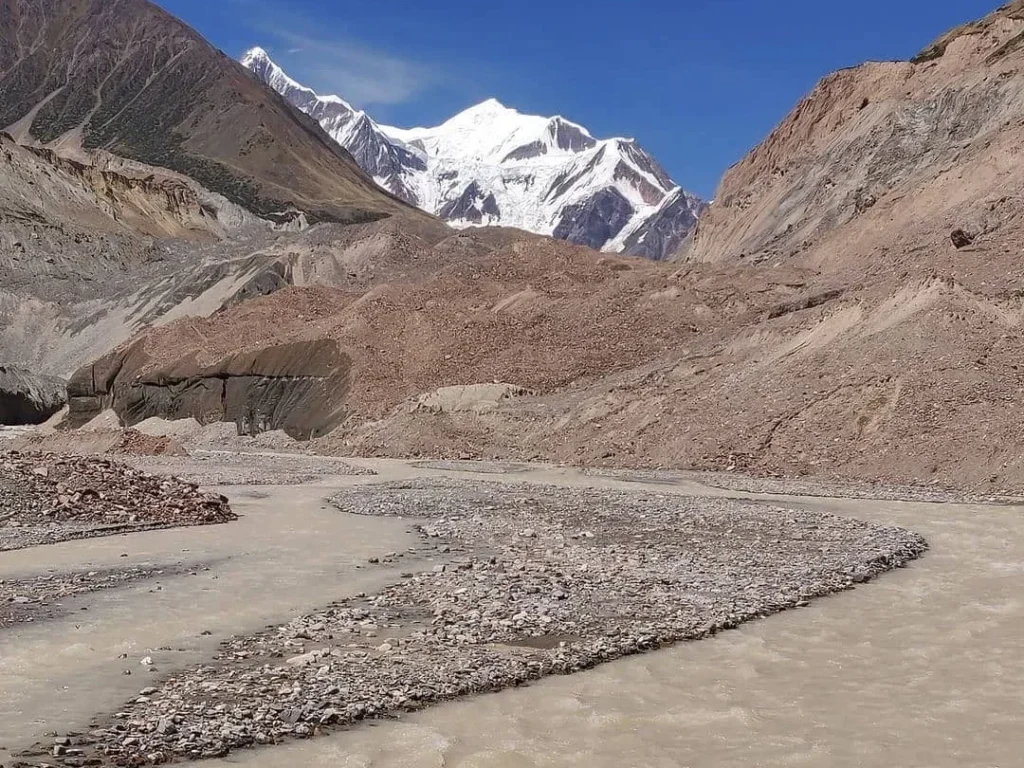
A more challenging yet culturally rich adventure, the Milam Glacier Trek takes you to one of the largest glaciers in the Kumaon Himalayas, nestled at an altitude of around 13,860 feet. The trek spans 10 to 12 days, starting from Munsiyari and passing through ancient trade villages like Lilam, Bugdiar, Rilkot, and Martoli—remnants of Indo-Tibetan commerce.
The route is rugged, with multiple river crossings, suspension bridges, and moraine-filled landscapes. The final stretch to Milam Glacier offers dramatic views of Trishul, Nanda Devi East, and Hardeol peaks. This trek is moderate to challenging in difficulty, suitable for experienced trekkers with good fitness levels. Due to its proximity to the Indo-Tibetan border, permits and SSB (border security) clearances are required. The best time to embark on this trek is May to June and September to mid-October.
Nanda Devi East Base Camp
For those seeking a spiritual and strenuous adventure, the Nanda Devi East Base Camp Trek is a revered journey. Positioned at an altitude of about 4,300 meters (14,100 feet), this trek offers close encounters with the sanctified eastern face of Nanda Devi (7,434 m)—considered a goddess by the locals. Starting again from Munsiyari, the route shares initial stretches with the Milam trek before diverting toward Nandabhanar and Lawan Glacier.
The trek typically spans 11 to 12 days and involves alpine meadows, glacial ridges, and rocky terrain, making it a moderate to difficult experience. The trail runs through ecologically sensitive and geopolitically significant zones, necessitating permits and often a registered guide. Ideal months for this trek are May–June and September, with crystal-clear views and bearable cold.
Sunderdhunga Valley Trek
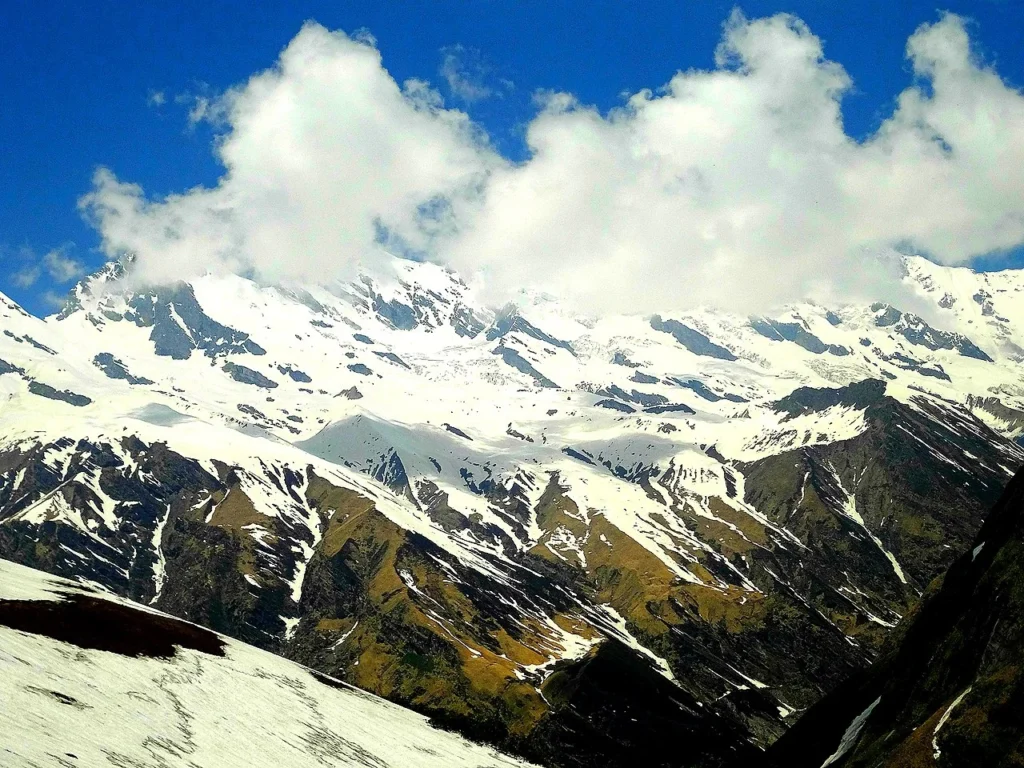
The Sunderdhunga Valley Trek, meaning “Valley of Beautiful Stones,” is one of Kumaon’s most enchanting yet lesser-explored routes. This trek ascends to around 4,100 meters (13,450 feet) and generally takes 8 to 10 days to complete. The trail begins at Bageshwar and converges with the Pindari route until Khati, before diverging through Jatoli and Kathalia toward glacier points like Maiktoli Glacier, Baluni Top, and Sukhram Cave.
The terrain is diverse—lush green meadows, dense forests, fast-flowing rivers, and later, steep rocky trails leading to icy wilderness. Trekkers are rewarded with views of snow-capped giants like Maiktoli, Panwali Dwar. This trek is rated moderate to challenging and is best done between May–June and September–October.
Panchachuli Base Camp Trek

One of the most visually iconic treks in Kumaon, the Panchachuli Base Camp Trek leads to the base of the stunning Panchachuli Peaks I–V, rising above the Darma Valley. The trek can be completed in 6 to 7 days. It starts from Dharchula and passes through scenic hamlets like Dar, Sela, Nagling, and Baaling, tracing the course of the Gori Ganga River.
The trail comprises forested tracks, hanging bridges, glaciers, and panoramic Himalayan views. Along the way, one can witness the Meola and Saun glaciers—feeder glaciers of the Panchachuli massif. This trek is rated moderate and is best done from May to June or September onwards. Due to its proximity to the international border, permits and multiple ID checks are mandatory.
Adi Kailash and Om Parvat Trek
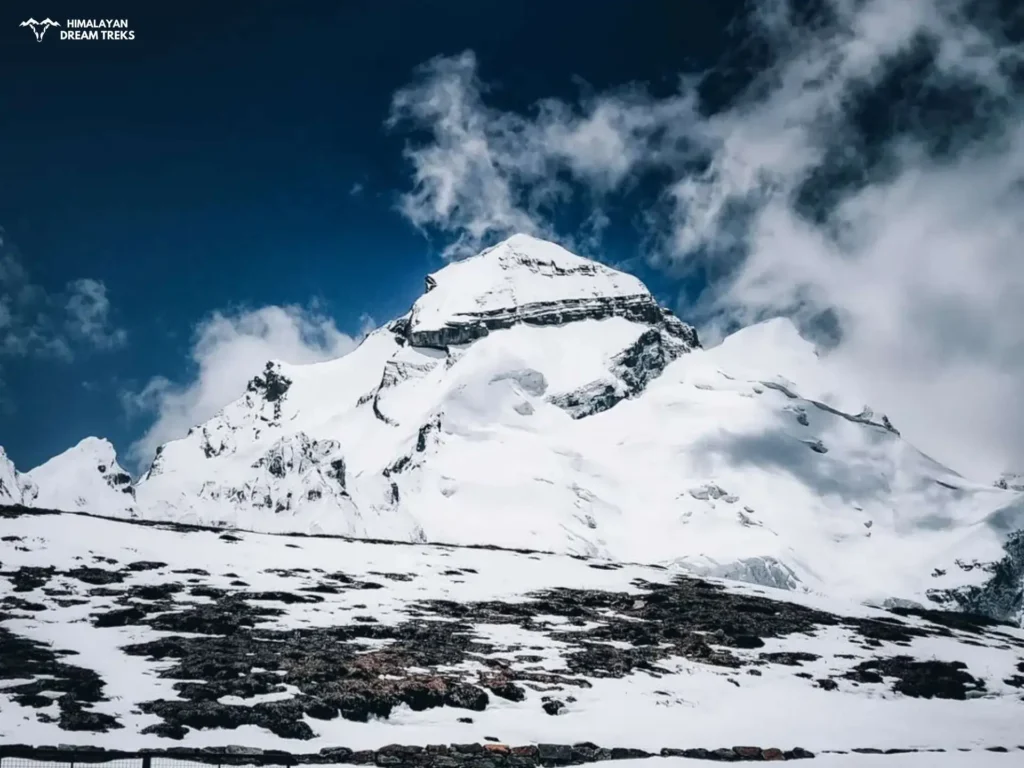
For spiritual seekers and trekkers alike, the Adi Kailash Yatra offers a divine experience amidst Himalayan desolation. Sitting at 15,748 feet, Adi Kailash is considered the earthly abode of Lord Shiva, mirroring Mount Kailash in Tibet. The trek begins at Pithoragarh, proceeds to Dharchula, Gunji, and Kuti, and finally reaches Jolingkong, near Parvati Sarovar.
Trekkers also get a glimpse of Om Parvat, a peak with a natural snow formation of the sacred ‘Om’ symbol. This journey takes 9 to 11 days and includes spiritual rituals, stark high-altitude desert terrain, and deep silence. The difficulty is moderate due to altitude rather than terrain. Inner Line Permits and SSB clearance are compulsory, and the trek is usually organized by KMVN or approved agencies during May–June and September.
Nature and Scenic Beauty:

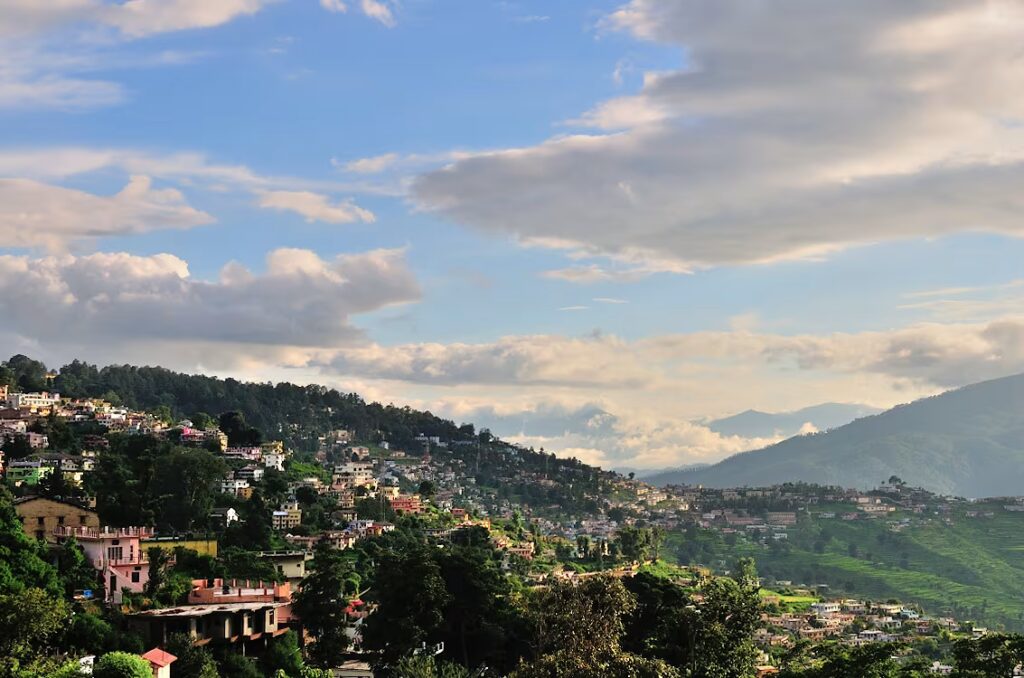
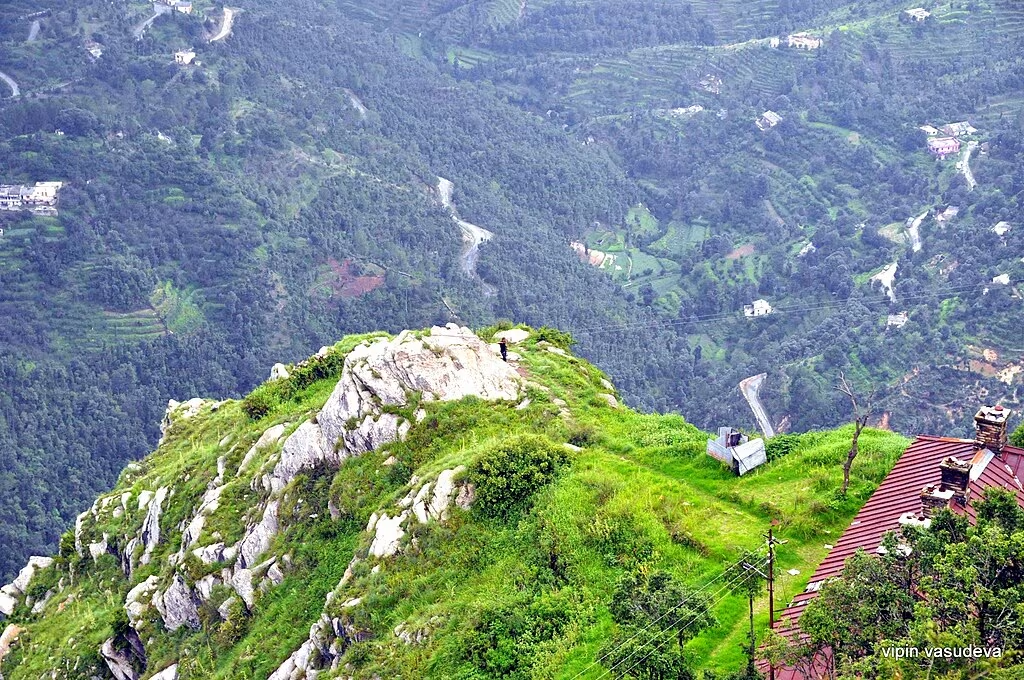
Nainital
The crown jewel of Kumaon, Nainital is a charming lake town surrounded by misty hills. Boating on the emerald Naini Lake, walking along the Mall Road, or watching the sunrise from Snow View Point are timeless experiences.
Bhimtal, Naukuchiatal & Sattal
These lake towns near Nainital offer tranquility far from the crowds. Each has its own charm—Bhimtal for boating, Naukuchiatal for birdwatching, and Sattal for its cluster of seven lakes surrounded by dense forests.
Almora
A cultural hill station wrapped in pine forests, Almora is known for its artistic heritage, panoramic mountain views, and ancient temples. It’s a great base for exploring spiritual sites like Jageshwar and Kasar Devi.
Mukteshwar
A peaceful retreat famous for apple orchards, colonial-era cottages, and uninterrupted views of the Himalayas. Don’t miss the cliffside Mukteshwar Dham Temple and nearby adventure spots like Chauli ki Jali.
Chaukori
Still off the beaten path, Chaukori is ideal for watching the golden glow of Himalayan peaks at sunrise. Surrounded by tea gardens and dense deodar forests, it’s serenity in its purest form.
Munsiyari
Called the “Little Kashmir” of Uttarakhand, Munsiyari is a dreamy village that opens up to views of the majestic Panchachuli peaks. It’s also the base for glacier treks like Milam, Ralam, and Khalia Top.
Spiritual & Temple Destinations
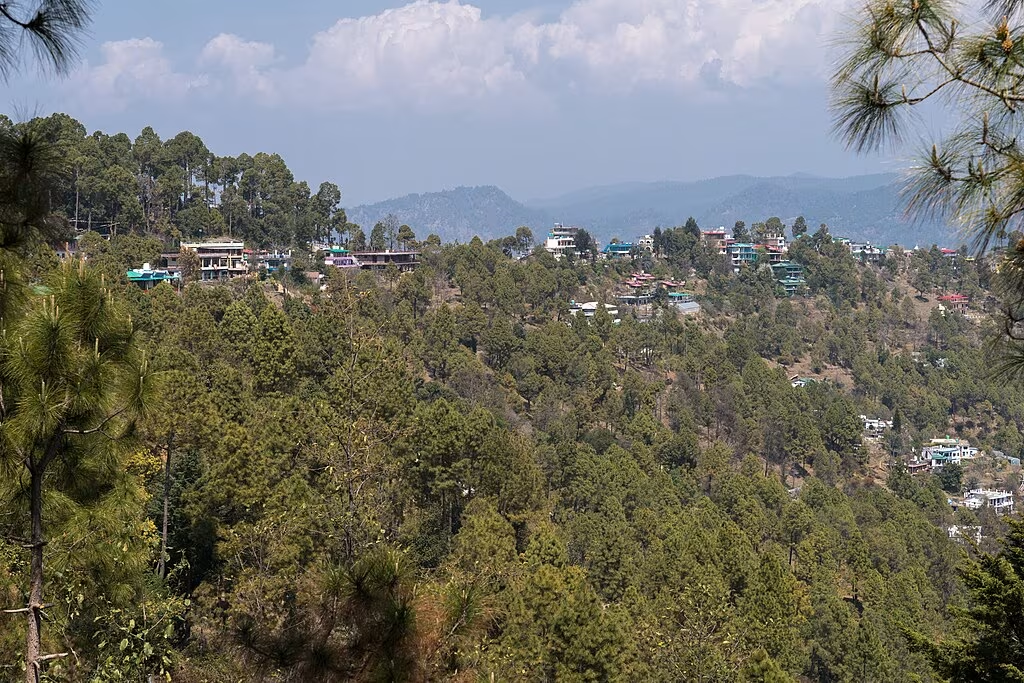

Jageshwar Dham
This ancient temple complex near Almora consists of 124 stone temples dating back to the 9th century. Surrounded by dense deodar forest, it’s peaceful, mystical, and deeply spiritual.
Baijnath Temple
Located by the river Gomti in Bageshwar, this 12th-century temple dedicated to Lord Shiva is serene and steeped in history. The river views and calm atmosphere make it ideal for contemplation.
Kasar Devi
A spiritual power spot recognized on the global geomagnetic map, Kasar Devi has attracted seekers like Swami Vivekananda and Allen Ginsberg. Visit for calm energy, Himalayan views, and poetic sunrises.
Katarmal Sun Temple
This 800-year-old temple dedicated to the Sun God is a forgotten marvel near Almora. Its ancient stone structure and panoramic location make it a photographer’s dream.
Bagnath Temple
Located at the sacred confluence of the Gomti and Sarayu rivers, this Shiva temple is a major pilgrimage site and central to the grand Uttarayani Mela held every January.
Wildlife & Nature Sanctuaries
Jim Corbett National Park
Named after Jim Corbett, this national park is famous for its tigers. He spent much of his life in Kumaon, his book, “Man-Eaters of Kumaon,” details his experiences in the region. Safari through Sal forests, riverbanks, and grasslands is thrilling for both wildlife lovers and photographers.
Binsar Wildlife Sanctuary
A high-altitude forested haven for leopards, barking deer, and over 200 bird species. The Zero Point here offers a jaw-dropping 360° view of the snowy Himalayas.
How to Plan Your Travel to Kumaon Himalayas
Best Time to Visit
March–June: Pleasant weather (15°C–25°C) ideal for sightseeing.
September–November: Post-monsoon clarity for trekking.
Avoid July–August due to landslides and December–February for extreme cold.
How to Reach
Air: Pantnagar Airport (137 km from Nainital) connects to Delhi.
Rail: Kathgodam (35 km from Nainital) is the nearest major station.
Road: Well-connected from Delhi and major cities.
The Kumaon Himalayas, is a beautiful blend of natural splendor and cultural heritage. The region offers a journey that transcends the ordinary—a journey into the soul of the Himalayas.
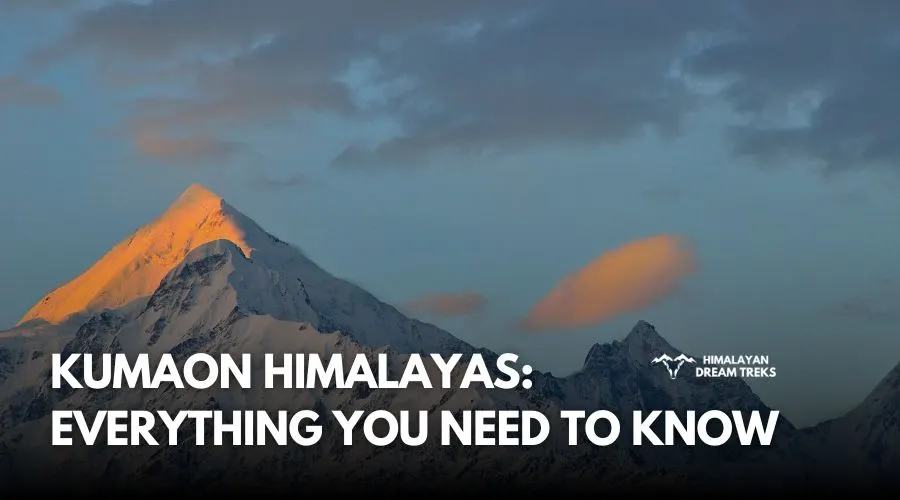
Leave a Comment